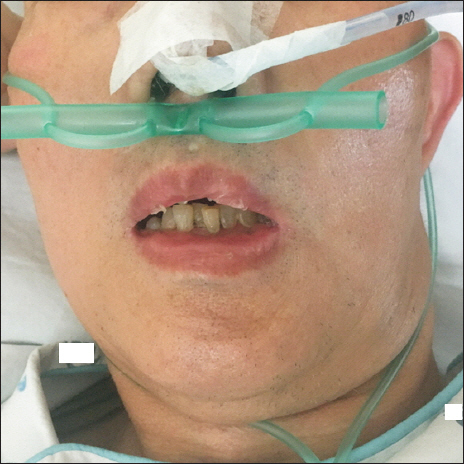Anesth Pain Med.
2018 Apr;13(2):149-153. 10.17085/apm.2018.13.2.149.
Difficult intubation of a patient with progressive multifocal leukoencephalopathy and muscle spasticity: A case report
- Affiliations
-
- 1Department of Anesthesiology and Pain Medicine, National Medical Center, Seoul, Korea. kimje78@gmail.com
- KMID: 2437420
- DOI: http://doi.org/10.17085/apm.2018.13.2.149
Abstract
- Progressive multifocal leukoencephalopathy (PML) is a demyelinating central nervous system disease characterized by neurological deficits, including cognitive impairment, altered mental status, and muscle spasticity. Preoperative evaluation and intraoperative airway management of the airway is difficult in patients with this disease. In this report, the authors describe a 62-year-old man with PML and spastic hemiparesis, who was scheduled for video-assisted thoracic bullectomy under general anesthesia. A preoperative airway evaluation, including Mallampati classification, could not be performed due to lack of patient cooperation. Additionally, the anesthesiologist did not perform diverse physical assessments of the airway or prepare an adequate airway management strategy. During induction of general anesthesia, difficulty with intubation was encountered because of limited mouth opening. This case emphasizes that anesthesiologists should have thorough knowledge of airway assessment and management strategies, and perform a comprehensive assessment to implement appropriate airway management in patients with this disease.
MeSH Terms
Figure
Reference
-
1. Tan CS, Koralnik IJ. Progressive multifocal leukoencephalopathy and other disorders caused by JC virus: clinical features and pathogenesis. Lancet Neurol. 2010; 9:425–37. DOI: 10.1016/S1474-4422(10)70040-5.2. Asensi V, Asensi JM, Carton JA, Maradona JA, Oña M, Aréchaga C. Successful intrathecal ethanol block for intractable spasticity of AIDS-related progressive multifocal leukoencephalopathy. Spinal Cord. 1999; 37:450–2. DOI: 10.1038/sj.sc.3100859. PMID: 10432267.3. Nho JS, Shin DS, Moon JY, Yi JW, Kang JM, Lee BJ, et al. Anesthetic management of an adult patient with Rett syndrome and limited mouth opening -A case report-. Korean J Anesthesiol. 2011; 61:428–30. DOI: 10.4097/kjae.2011.61.5.428. PMID: 22148093. PMCID: PMC3229023.4. Berger JR, Aksamit AJ, Clifford DB, Davis L, Koralnik IJ, Sejvar JJ, et al. PML diagnostic criteria: consensus statement from the AAN Neuroinfectious Disease Section. Neurology. 2013; 80:1430–8. DOI: 10.1212/WNL.0b013e31828c2fa1. PMID: 23568998. PMCID: PMC3662270.5. Gupta S, Sharma R, Jain D. Airway assessment: predictors of difficult airway. Indian J Anaesth. 2005; 49:257–62.6. Dhanrajani PJ, Jonaidel O. Trismus: aetiology, differential diagnosis and treatment. Dent Update. 2002; 29:88–92. 94. DOI: 10.12968/denu.2002.29.2.88. PMID: 11928347.7. Aiello G, Metcalf I. Anaesthetic implications of temporomandibular joint disease. Can J Anaesth. 1992; 39:610–6. DOI: 10.1007/BF03008329. PMID: 1643688.8. Sheean G, McGuire JR. Spastic hypertonia and movement disorders: pathophysiology, clinical presentation, and quantification. PM R. 2009; 1:827–33. DOI: 10.1016/j.pmrj.2009.08.002. PMID: 19769916.9. Ariës MJ, Vroomen PC, van der Hoeven JH, De Keyser J. Trismus as manifestation of bilateral internal capsule genu infarction. Clin Neurol Neurosurg. 2008; 110:305–6. DOI: 10.1016/j.clineuro.2007.11.009. PMID: 18187255.10. Bhola N, Jadhav A, Borle R, Khemka G, Ajani AA. Awake endotracheal retrograde intubation in restricted mouth opening: a 'J'-tipped guide wire technique--a retrospective study. Oral Maxillofac Surg. 2014; 18:393–6. DOI: 10.1007/s10006-013-0419-0. PMID: 23813051.11. Rehman MA, Schreiner MS. Oral and nasotracheal light wand guided intubation after failed fibreoptic bronchoscopy. Paediatr Anaesth. 1997; 7:349–51. DOI: 10.1046/j.1460-9592.1997.d01-85.x.12. Morris IR. Fibreoptic intubation. Can J Anaesth. 1994; 41:996–1008. DOI: 10.1007/BF03010944. PMID: 8001220.13. Campos JH. Current techniques for perioperative lung isolation in adults. Anesthesiology. 2002; 97:1295–301. DOI: 10.1097/00000542-200211000-00036. PMID: 12411817.14. Frerk C, Mitchell VS, McNarry AF, Mendonca C, Bhagrath R, Patel A, et al. Difficult Airway Society 2015 guidelines for management of unanticipated difficult intubation in adults. Br J Anaesth. 2015; 115:827–48. DOI: 10.1093/bja/aev371. PMID: 26556848. PMCID: PMC4650961.
- Full Text Links
- Actions
-
Cited
- CITED
-
- Close
- Share
- Similar articles
-
- Recurrent Complex Partial Seizures in a Patient with Progressive Multifocal Leukoencephalopathy
- Hypointense Rim on Susceptibility-Weighted Imaging in a Patient with Progressive Multifocal Leukoencephalopathy
- Progressive Multifocal Leukoencephalopathy in a Patient with T Cell Lymphoma of Head and Neck: A Case Report
- Progressive Multifocal Leukoencephalopathy With Hyper-IgM Syndrome in a 6-Year-Old Boy
- Progressive Multifocal Leukoencephalopathy Presenting as Viral Encephalitis in a Healthy Adult



